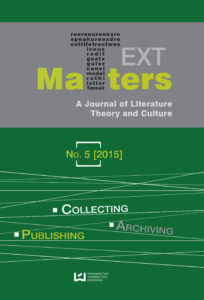“An Inner Comprehension of the Pueblo Indian’s Point of View”: Carl Gustav Jung’s 1925 Visit to Taos, New Mexico
DOI:
https://doi.org/10.1515/texmat-2015-0013Abstract
Carl Jung paid a short visit to Taos, New Mexico, in January 1925. A brief account of his stay at the Pueblo appeared in Memories, Dreams, Reflections, edited by Aniela Jaffe in 1963. Remembering his conversations with Mountain Lake (Antonio Mirabal), Jung wrote of the confrontation between the “European consciousness,” or the “European thought,” with the Indian “unconscious.” My article provides a reading of Jung’s text as a meeting ground of the aesthetic, emotional, visionary and of the analytical, rational, explanatory. Like many other European and Anglo-American visitors to Taos Pueblo, Jung rediscovers its capacity to mirror the inner needs of the visitor; he examines the significance of the encounter with the Southwestern landscape and with the Pueblo Indians’ religious views in terms of self-reflection and of the return to the mythical. As Carl Jung’s “inner comprehension” of the Pueblo Indian’s philosophy is mediated through language, aware both of its desire and its inability to become liberated from the European perspectives, Mountain Lake’s attitude towards his visitor from Switzerland remains ultimately unknown; Mountain Lake does, however, communicate his readiness to assume the archetypal role of a teacher and a spiritual guide whose insights reach beyond the confines and mystifications of language. According to Jung’s account, during this brief encounter of the two cultures, he and his Indian host experienced a sense of satisfaction and fulfillment, the sources of which, as they both understood them in their own individual ways, resided in the comprehension of universal sharing.
Downloads
References
Burkhart, Brian Yazzie. “What Coyote and Thales Can Teach Us: An Outline of American Indian Epistemology.” American Indian Thought: Philosophical Essays. Ed. Anne Waters. Malden, MA: Blackwell, 2004. 15-26. Print.
Google Scholar
Cather, Willa. Death Comes for the Archbishop. New York: Knopf, 1968. Print.
Google Scholar
Jung, Carl Gustav. Memories, Dreams, Reflections. Ed. Aniela Jaffé. Trans. Richard and Clara Winston. New York: Vintage, 1963. Print.
Google Scholar
Lawrence, D. H. The Collected Letters of D. H. Lawrence. Ed. Harry T. Moore. New York: Viking, 1962. Print.
Google Scholar
Mankoff, Robert. The Complete Cartoons of The New Yorker. New York: Black Dog & Leventhal, 2004. Print.
Google Scholar
Rudnick, Lois Palken. Utopian Vistas: The Mabel Dodge Luhan House and the American Counterculture. Albuquerque: U of New Mexico P, 1996. Print.
Google Scholar
Downloads
Published
How to Cite
Issue
Section
License

This work is licensed under a Creative Commons Attribution-NonCommercial-NoDerivatives 4.0 International License.













